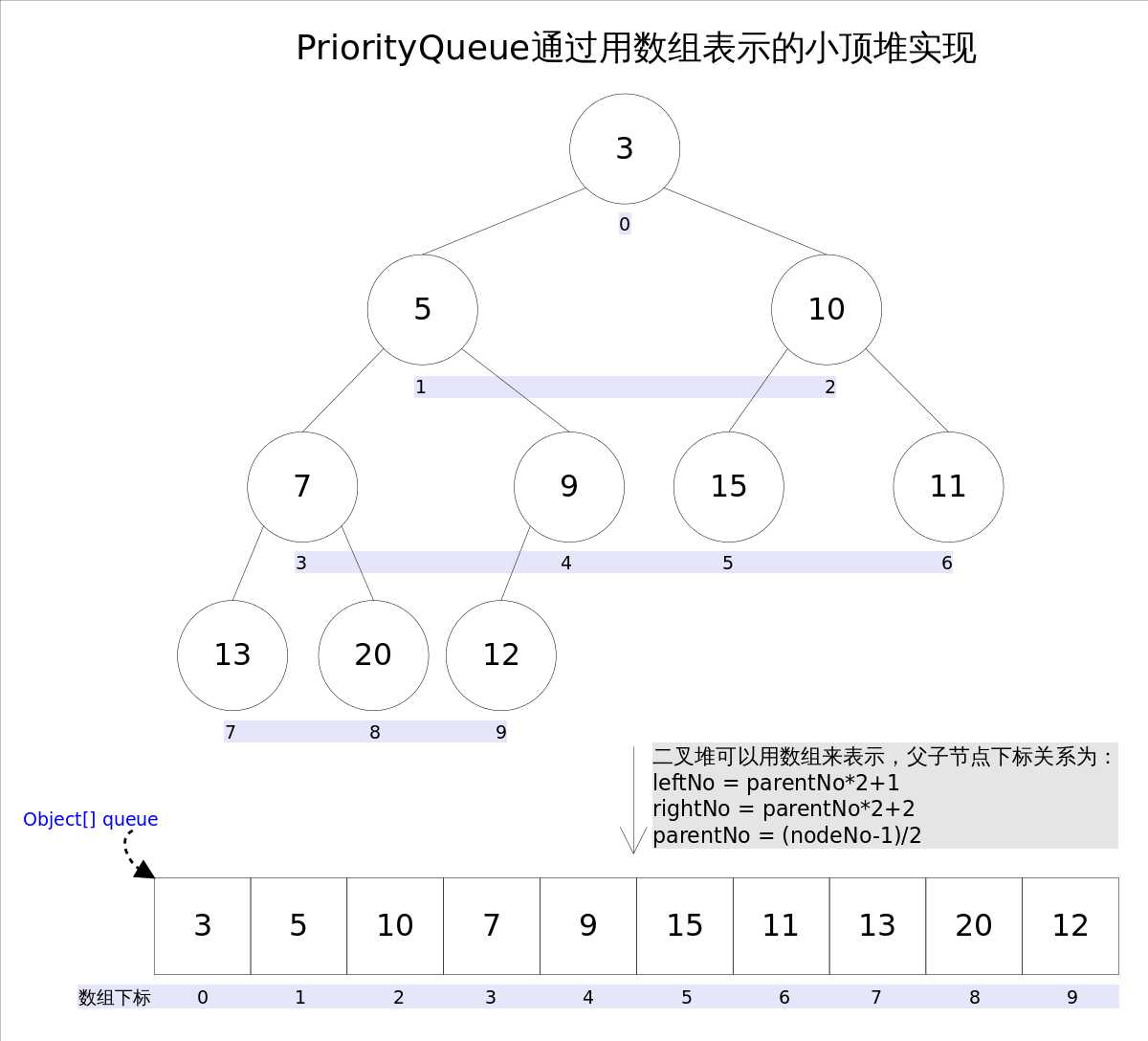标签:节点 元素 point code 其它 OLE png 左右 ror
一个无界的队列
基于优先级堆(Java中的PQ相当于最小堆)
priority queue中的元素的顺序基于Comparable原始的顺序或者由构造时提供的Comparator提供
priority queue中不能有null元素,有null元素还怎么比大小。当然也不允许插入一个不可比较(non-comparable)的对象(如果你插入一个non-comparable对象,则会抛出一个ClassCastException异常)
priority queue是无界的,但是内部有capacity属性来管理用于存储数据的数组的大小(priority queue基于数组)
iterator()不能保证按照指定顺序遍历pq中的元素,如果对遍历顺序有需求的话,使用Arrays.sort(pq.toArray())
pq不是线程安全的,如果要使用线程安全的版本,使用java.util.concurrent.PriorityBlockingQueue
出队入队的时间复杂度:O(log(n))(因为要做上移和下移来保证顺序)
public class PriorityQueue<E> extends AbstractQueue<E>
implements java.io.Serializable
/**
* Priority queue represented as a balanced binary heap: the two
* children of queue[n] are queue[2*n+1] and queue[2*(n+1)]. The
* priority queue is ordered by comparator, or by the elements‘
* natural ordering, if comparator is null: For each node n in the
* heap and each descendant d of n, n <= d. The element with the
* lowest value is in queue[0], assuming the queue is nonempty.
*/
transient Object[] queue;
private int size = 0;
/**
* The comparator, or null if priority queue uses elements‘
* natural ordering.
*/
private final Comparator<? super E> comparator;
transient int modCount = 0;

优先级队列表现为一个平衡二项堆(即,平衡二叉树):queue[n]的两个儿子分别是queue[2n+1]和queue[2(n+1)]。优先级队列通过比较器(comparator)来排序,或者如果比较器为空则通过元素的自然顺序来排序:堆中每个节点n和n的每个后裔节点d,n <= d。假设队列是非空的,那么具有最低值的元素在queue[0]。
leftNo = parentNo*2+1
rightNo = parentNo*2+2
parentNo = (nodeNo-1)/2
通过上述三个公式,可以轻易计算出某个节点的父节点以及子节点的下标。这也就是为什么可以直接用数组来存储堆
Double size if small; else grow by 50%
private void grow(int minCapacity) {
int oldCapacity = queue.length;
// Double size if small; else grow by 50%
int newCapacity = oldCapacity + ((oldCapacity < 64) ?
(oldCapacity + 2) :
(oldCapacity >> 1));
// overflow-conscious code
if (newCapacity - MAX_ARRAY_SIZE > 0)
newCapacity = hugeCapacity(minCapacity);
queue = Arrays.copyOf(queue, newCapacity);
}
private static int hugeCapacity(int minCapacity) {
if (minCapacity < 0) // overflow
throw new OutOfMemoryError();
return (minCapacity > MAX_ARRAY_SIZE) ?
Integer.MAX_VALUE :
MAX_ARRAY_SIZE;
}
public boolean offer(E e) {
if (e == null)
throw new NullPointerException();
modCount++;
int i = size;
if (i >= queue.length)
grow(i + 1);
size = i + 1;
if (i == 0)
queue[0] = e;
else
siftUp(i, e);
return true;
}
插入操作会通过siftUp调整堆结构的,时间复杂度:O(log(n))

private void siftUp(int k, E x) {
if (comparator != null)
siftUpUsingComparator(k, x);
else
siftUpComparable(k, x);
}
@SuppressWarnings("unchecked")
private void siftUpComparable(int k, E x) {
Comparable<? super E> key = (Comparable<? super E>) x;
while (k > 0) {
int parent = (k - 1) >>> 1;
Object e = queue[parent];
if (key.compareTo((E) e) >= 0)
break;
queue[k] = e;
k = parent;
}
queue[k] = key;
}
@SuppressWarnings("unchecked")
private void siftUpUsingComparator(int k, E x) {
while (k > 0) {
int parent = (k - 1) >>> 1;
Object e = queue[parent];
if (comparator.compare(x, (E) e) >= 0)
break;
queue[k] = e;
k = parent;
}
queue[k] = x;
}
补充:
“>>>”代表无符号右移,不管要右移的数是正还是负,左边都填0
“>>”代表有符号右移,右移正数左边补0,右移负数左边补1
element()和peek()的语义完全相同,都是获取但不删除队首元素,也就是队列中权值最小的那个元素,二者唯一的区别是当方法失败时前者抛出异常,后者返回null。根据小顶堆的性质,堆顶那个元素就是全局最小的那个;由于堆用数组表示,根据下标关系,0下标处的那个元素既是堆顶元素。所以直接返回数组0下标处的那个元素即可。
public E peek() {
return (size == 0) ? null : (E) queue[0];
}
remove()和poll()方法的语义也完全相同,都是获取并删除队首元素,区别是当方法失败时前者抛出异常,后者返回null。由于删除操作会改变队列的结构,为维护小顶堆的性质,需要进行必要的调整。

public E poll() {
if (size == 0)
return null;
int s = --size;
modCount++;
E result = (E) queue[0];
E x = (E) queue[s];
queue[s] = null;
if (s != 0)
siftDown(0, x);
return result;
}
private void siftDown(int k, E x) {
int half = size >>> 1;
while (k < half) {
//首先找到左右孩子中较小的那个,记录到c里,并用child记录其下标
int child = (k << 1) + 1;//leftNo = parentNo*2+1
Object c = queue[child];
int right = child + 1;
if (right < size &&
comparator.compare((E) c, (E) queue[right]) > 0)
c = queue[child = right];
if (comparator.compare(x, (E) c) <= 0)
break;
queue[k] = c;//然后用c取代原来的值
k = child;
}
queue[k] = x;
}
remove(Object o)方法用于删除队列中跟o相等的某一个元素(如果有多个相等,只删除一个),该方法不是Queue接口内的方法,而是Collection接口的方法。由于删除操作会改变队列结构,所以要进行调整;又由于删除元素的位置可能是任意的,所以调整过程比其它函数稍加繁琐。具体来说,remove(Object o)可以分为2种情况:1. 删除的是最后一个元素。直接删除即可,不需要调整。2. 删除的不是最后一个元素,从删除点开始以最后一个元素为参照调用一次siftDown()即可。此处不再赘述。

//remove(Object o)
public boolean remove(Object o) {
//通过遍历数组的方式找到第一个满足o.equals(queue[i])元素的下标
int i = indexOf(o);
if (i == -1)
return false;
int s = --size;
if (s == i) //情况1
queue[i] = null;
else {
E moved = (E) queue[s];
queue[s] = null;
siftDown(i, moved);//情况2
......
}
return true;
}
https://www.cnblogs.com/Elliott-Su-Faith-change-our-life/p/7472265.html
标签:节点 元素 point code 其它 OLE png 左右 ror
原文地址:https://www.cnblogs.com/swifthao/p/12944037.html